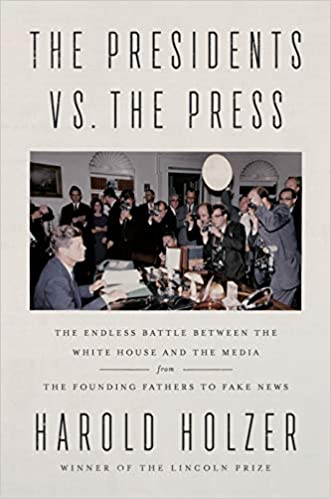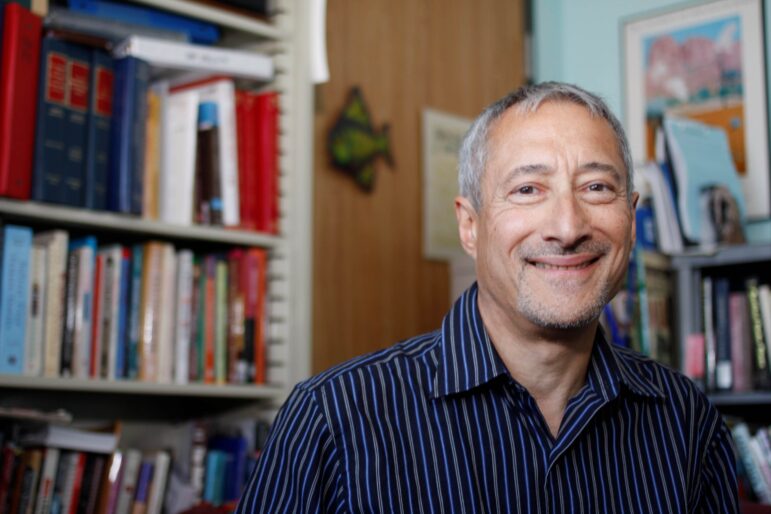By ERIC FREEDMAN
Capital News Service
LANSING – Incensed by a political cartoon that taunted his foreign policy, the president of the United States “hurled” the offensive cartoon to the floor as the Cabinet watched and went into a tirade “on the personal abuse bestowed on him” by opposition journalists, as historian and biographer Harold Holzer describes the scene.
The irate president “defied any man on earth to produce one single act of his since he had been in government which was not done on the purest motives.” And he railed that the opposition press targeted him for “the grossest and most insidious misrepresentations” and printed “exaggerated and odious” articles about him.
That president who flayed the press for daring to criticize him?
No, not Donald Trump, who certainly flays the news media in similar ire. For example: “There is great anger in our Country caused in part by inaccurate and even fraudulent reporting of the news. The Fake News Media, the true Enemy of the People, must stop the open & obvious hostility & report the news accurately & fairly.”
No, the first presidential attacks on the press came from George Washington.
And such attacks have never disappeared, Holzer says in his new book, “The Presidents vs. the Press: The Endless Battle between the White House and the Media–from the Founding Fathers to Fake News” (Dutton, $30). He is the director of the Roosevelt House Public Policy Institute at Hunter College in New York City.

Even presidents much-beloved now, such as Abraham Lincoln, Theodore Roosevelt and Franklin Roosevelt, found ways to attack and circumvent the press.
In other words, our presidents have not been reluctant to assail journalists for doing their jobs on behalf of the citizenry, although some have been louder and more in-your-face than others.
Consider Michigan’s only president, Gerald Ford of Grand Rapids, who moved into the White House after Richard Nixon resigned.
Ford named veteran Michigan reporter Jerald terHorst as press secretary, and as Holzer writes, the Grand Rapids-born terHorst “took over the job amid high expectations for the restoration of both access and honesty.”
Ford’s initial relations with the press were smooth – but not for long.
After only one month on the job, terHorst quit as a matter of principle when Ford pardoned Nixon.
TerHorst said senior White House aides had misled him to believe that Ford would allow “the legal process against Nixon to unfold unimpeded,” Holzer wrote.
And based on that misinformation, terHorst in turn misled the press corps.
After leaving the White House, he returned to the Detroit News and received the American Society of Journalists and Authors Conscience in Media Award.
While Ford espoused “more exposure and access rather than less,” he and the press corps did have their differences, although their overall relationship was much more cordial than that of many other modern presidents, according to Holzer.
In addition, there was a time in this fair land when reporters kept presidential secrets – whether truly personal or health-related – hush-hush.
My former Detroit News colleague, the late George Weeks of Glen Arbor, worked in Washington on the international desk of United Press International during the Kennedy administration. Once when his news agency’s White House reporter was on vacation, Weeks was assigned to cover President John Kennedy’s weekend visit to Camp David.
Weeks and another journalist were standing outside their motel near the entrance to Camp David when a limousine drove by en route to the presidential retreat.
Turning to his colleague, Weeks said, “That looked like Marilyn Monroe in the limousine.”
“Of course it was Marilyn Monroe,” replied the colleague, who – unlike Weeks – was well aware of Kennedy’s affair with Monroe. So were many other members of the White House press corps, although nothing about the president’s infidelities appeared in the press until long after Kennedy’s assassination.
A short drive from Mount Rushmore, Rapid City, South Dakota, promotes itself as the “City of Presidents” with life-sized bronze statues of every president from George Washington to Barack Obama on the downtown street corners.
Franklin Roosevelt’s statue shows the 32nd president, standing in front of the podium with radio microphones arrayed in front of him at a press conference.
Only by walking behind the statue can passers-by see the heavy metal braces FDR wore because of a bout of polio as a young man.
Journalists kept the president’s physical disability from the American public although they were fully aware of it. Photographers didn’t take pictures of FDR in the leg braces or being carried by his Secret Service detail.
Candidates know when they enter politics that they’re stepping into the public spotlight, and the higher the office –up to the presidency – the brighter that spotlight will shine.
Today’s journalists wouldn’t keep secret a president’s sexual infidelity or disability.
Nor should they. After all, their mission, as protected by the First Amendment, is to present news and information to the public, not to hide it.
Eric Freedman is director of Capital News Service.
By ERIC FREEDMAN
Capital News Service
LANSING – Incensed by a political cartoon that taunted his foreign policy, the president of the United States “hurled” the offensive cartoon to the floor as the Cabinet watched and went into a tirade “on the personal abuse bestowed on him” by opposition journalists, as historian and biographer Harold Holzer describes the scene.
The irate president “defied any man on earth to produce one single act of his since he had been in government which was not done on the purest motives.” And he railed that the opposition press targeted him for “the grossest and most insidious misrepresentations” and printed “exaggerated and odious” articles about him.
That president who flayed the press for daring to criticize him?
No, not Donald Trump, who certainly flays the news media in similar ire. For example: “There is great anger in our Country caused in part by inaccurate and even fraudulent reporting of the news. The Fake News Media, the true Enemy of the People, must stop the open & obvious hostility & report the news accurately & fairly.”
No, the first presidential attacks on the press came from George Washington.
And such attacks have never disappeared, Holzer says in his new book, “The Presidents vs. the Press: The Endless Battle between the White House and the Media–from the Founding Fathers to Fake News” (Dutton, $30). He is the director of the Roosevelt House Public Policy Institute at Hunter College in New York City.
Even presidents much-beloved now, such as Abraham Lincoln, Theodore Roosevelt and Franklin Roosevelt, found ways to attack and circumvent the press.
In other words, our presidents have not been reluctant to assail journalists for doing their jobs on behalf of the citizenry, although some have been louder and more in-your-face than others.
Consider Michigan’s only president, Gerald Ford of Grand Rapids, who moved into the White House after Richard Nixon resigned.
Ford named veteran Michigan reporter Jerald terHorst as press secretary, and as Holzer writes, the Grand Rapids-born terHorst “took over the job amid high expectations for the restoration of both access and honesty.”
Ford’s initial relations with the press were smooth – but not for long.
After only one month on the job, terHorst quit as a matter of principle when Ford pardoned Nixon.
TerHorst said senior White House aides had misled him to believe that Ford would allow “the legal process against Nixon to unfold unimpeded,” Holzer wrote.
And based on that misinformation, terHorst in turn misled the press corps.
After leaving the White House, he returned to the Detroit News and received the American Society of Journalists and Authors Conscience in Media Award.
While Ford espoused “more exposure and access rather than less,” he and the press corps did have their differences, although their overall relationship was much more cordial than that of many other modern presidents, according to Holzer.
In addition, there was a time in this fair land when reporters kept presidential secrets – whether truly personal or health-related – hush-hush.
My former Detroit News colleague, the late George Weeks of Glen Arbor, worked in Washington on the international desk of United Press International during the Kennedy administration. Once when his news agency’s White House reporter was on vacation, Weeks was assigned to cover President John Kennedy’s weekend visit to Camp David.
Weeks and another journalist were standing outside their motel near the entrance to Camp David when a limousine drove by en route to the presidential retreat.
Turning to his colleague, Weeks said, “That looked like Marilyn Monroe in the limousine.”
“Of course it was Marilyn Monroe,” replied the colleague, who – unlike Weeks – was well aware of Kennedy’s affair with Monroe. So were many other members of the White House press corps, although nothing about the president’s infidelities appeared in the press until long after Kennedy’s assassination.
A short drive from Mount Rushmore, Rapid City, South Dakota, promotes itself as the “City of Presidents” with life-sized bronze statues of every president from George Washington to Barack Obama on the downtown street corners.
Franklin Roosevelt’s statue shows the 32nd president, standing in front of the podium with radio microphones arrayed in front of him at a press conference.
Only by walking behind the statue can passers-by see the heavy metal braces FDR wore because of a bout of polio as a young man.
Journalists kept the president’s physical disability from the American public although they were fully aware of it. Photographers didn’t take pictures of FDR in the leg braces or being carried by his Secret Service detail.
Candidates know when they enter politics that they’re stepping into the public spotlight, and the higher the office –up to the presidency – the brighter that spotlight will shine.
Today’s journalists wouldn’t keep secret a president’s sexual infidelity or disability.
Nor should they. After all, their mission, as protected by the First Amendment, is to present news and information to the public, not to hide it.
Eric Freedman is director of Capital News Service.
